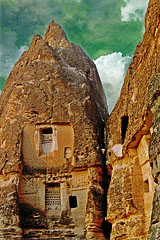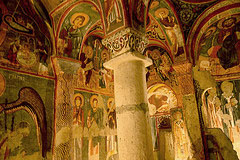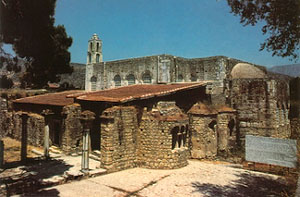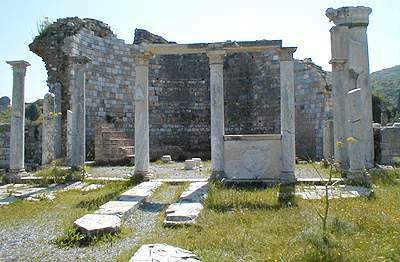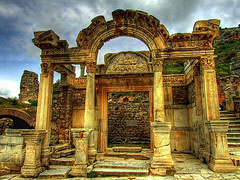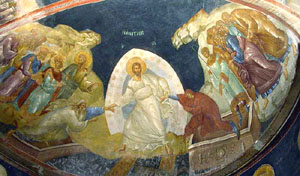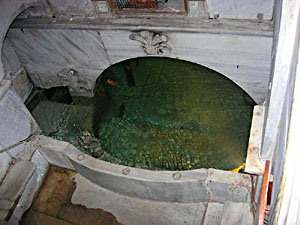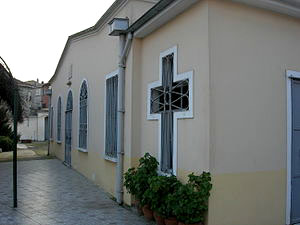 |
||||
|
A Pilgrimage to Asia Minor in October 2010 by Fr. Alexander G. Leondis |
||||
|
||||
| Our first experience was visiting the remarkable city of Cappadocia, appropriately considered a Wonder of the World. We had an earlier glimpse of it in Bob Simon’s “Sixty Minutes” which toured the area with Patriarch Bartholomew. (The video is available on the Archdiocese or Archons’ webpage.) Cappadocia in Caesarea is a fairy tale setting fashioned by the volcanic erosions, which formed chimney rocks for over ten thousand years. Within these formations are carved caves that are still decorated with fine Byzantine icons. |
||||
|
||||
|
After visiting the site of St. Basil, we traveled east to Myra, the city of St. Nicholas the Wonderworker, the protector of children and travelers, the person who eventually was to be called Santa Claus. After the death of St. Nicholas, a church was built over his relics. Decorated with beautiful Byzantine icons, it stands regally to this day. While all of our ancient churches are considered museums today and are held as Turkish property, I had a plan. Before I left on my pilgrimage, I had copied from my computer an icon of St. Nicholas and printed on it the names of those I know personally along with the entire Holy Trinity family. Walking among those icons, I found a secluded area of the Church where I squeezed the paper with the icon and names between two stones that St. Nicholas may always intercede for us. |
||||
|
||||
|
||||
| From Ephesus, we sojourned to Smyrna, where Homer wrote the “Iliad” and the “Odyssey” and where St. John the Evangelist served as its first bishop. Smyrna is a picturesque seaport city on the Aegean. In the Book of Revelation, it received an exemplary rating among the seven churches. |
||||
In Smyrna, the Greek Counsel General, the honorable Hara Skolarikou, received us at the consulate. We sorrowfully discussed the far-reaching slaughter of the Greek Orthodox Christians during the 1922 Catastrophe of Asia Minor. Her honor directed us to the area in the Bay of Smyrna where the water was turned red with Greek blood during the massacre of our people by the Turkish militia. A thriving Greek Orthodox community had been calling Smyrna their home for centuries. The 1922 census estimates there were 300,000 living there in contrast to the only 20,000 living in Athens. Those few who escaped the massacre regrettably left behind a multitude of Greek families, clergy, professionals, craftsmen and others to die treacherously in Asia Minor, unheralded by those who gave little or no aid. It is estimated that 1 million to 3 million Greeks were killed in Asia Minor by the Turkish army between 1922-23. |
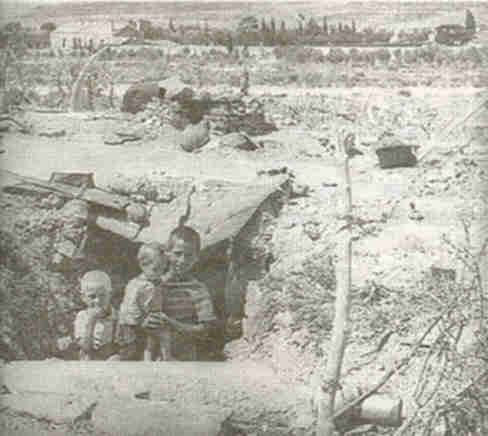 Smyrna, post conflagration (HCS collection) |
|||
 Smyrna, pre-1922 (HCS collection) |
||||
Unmistakably, Smyrna was an emotional experience for Mary and me, because our parents were descended from its suburbs, Mimas and Karaburun in Turkish. We were overcome with deep joy and sorrow—joy because we were in touch with our ancestral roots, sorrow because of the assault on our people who fled their homes without warning to save their lives. We found the ruins of our parents’ churches and offered memorial prayers for our ancestors. My grandfather Alexander was buried in the courtyard of the Church of St. Demetrios. Significantly, I visited this area 50 years ago when I was studying at Halki and can attest to the fact that little has changed since then. |
||||
|
Our next and final visit was to the Queen of Cities for us Orthodox Christians, Constantinople, the Mother Church, the Ecumenical Patriarchate and headquarters of world Orthodoxy. Once again, we experienced joy and sadness as we envisioned the past glory of Orthodoxy and mourned the present state of our Church. Constructed by Justinian, St. Sophia Church, dedicated to the Holy Wisdom of God, was the largest building in the world in the 6th century, predating St. Peter’s Church in Rome by some 1,000 years. The major hierarchs, St. John Chrysostom, St. Gregory of Nazianzus and other Fathers occupied the throne and preached in this magnificent house of worship. Here ecumenical councils took place, Byzantine music and art were perfected and our theology formulated. Many of the beautiful mosaics still survive. However, under Turkish rule, St. Sophia has been a museum since 1935. |
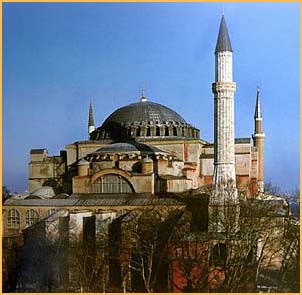 Haghia Sophia, Constantinople (HCS collection) |
|||
| When King Vladimir sent Russian envoys to determine the Faith of his nation, they entered St. Sophia and reported to him that they didn’t know whether they we were in heaven or on earth as they beheld the splendor and worship in this magnificent church. However, in 1453, St. Sophia was converted into a mosque when Sultan Mehmet the Second conquered Constantinople. The Muslims were so enamored with St. Sophia that from the 15th century on, all mosques are capped with a dome in imitation of this great edifice. |
||||
|
||||
| We visited Chora Monastery, which many historians and art specialists cite as having the finest and most beautiful mosaics in the world, dating from the classic 14th century Byzantine art style that reached its heights during this period. As they did with all stone churches, the Turks converted this beautiful house of worship into a mosque too. |
||||
|
||||
|
Later, we visited the Church of Vlahernae, where the hymn “Ti Ipermaho” was first sung in honor of the Theotokos. While the Byzantine army was fighting a battle away from Constantinople, the Avars attacked the queen city. The Christians turned to the Theotokos for protection, and here for the first time the Akathist Hymn was chanted in gratitude to the Mother of God for saving the city. |
||||
|
(Posting date 23 October 2011. Images supplied by HCS.) HCS encourages readers to view other articles and releases in our permanent, extensive archives at the URL http://www.helleniccomserve.com/contents.html. |
||||
|
||||
|
2000 © Hellenic Communication Service, L.L.C. All Rights Reserved.
http://www.HellenicComServe.com |
||||
